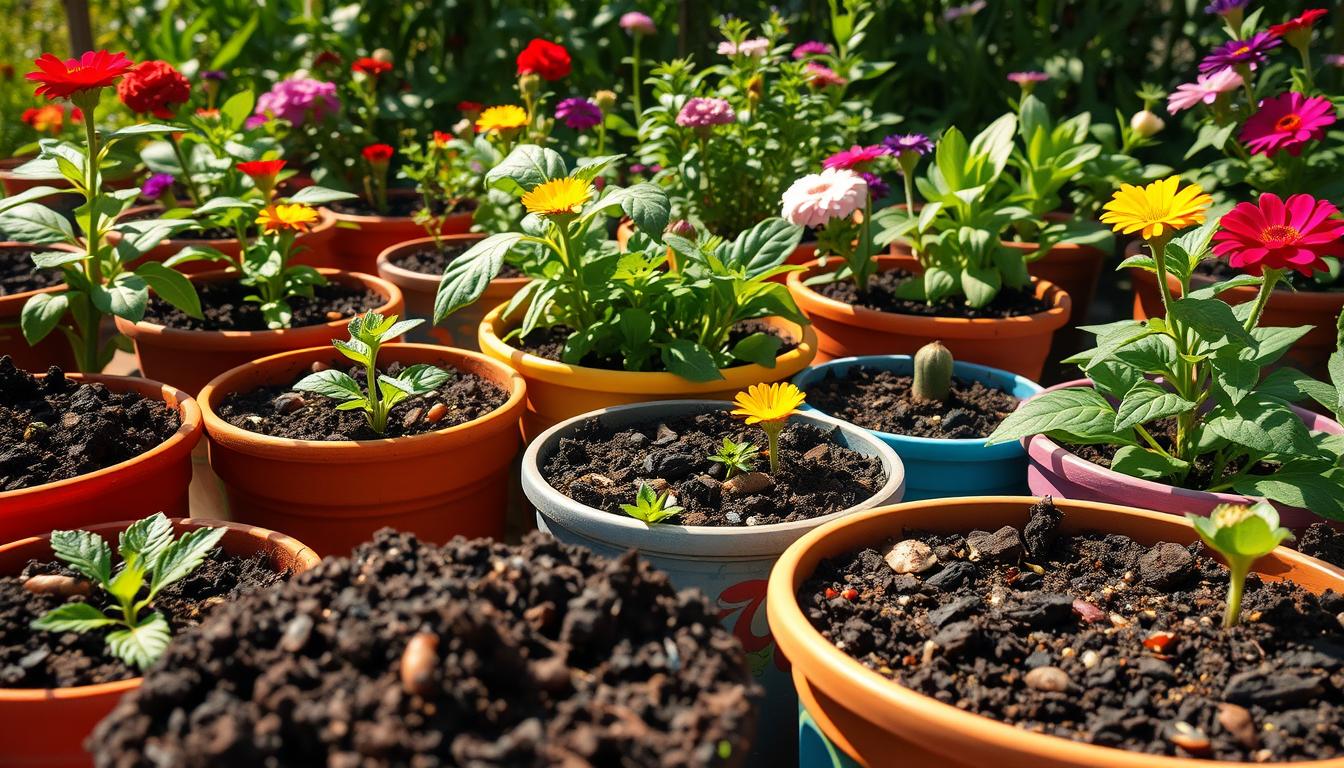As a container gardening enthusiast, I know how crucial it is to choose the best soil for container plants to ensure their growth and survival. With numerous options available, selecting the right container gardening soil can be overwhelming. In this article, I will share my expertise to help you find the ideal potting mix for potted plants, enabling you to cultivate a beautiful outdoor space.
I will guide you through the key components of quality container soil. We’ll discuss different types of soil mixes. And I’ll provide tips on how to choose the right soil for your plants. This will make it easier for you to create a thriving container garden with the perfect potting mix for potted plants and the best soil for container plants.
Why Soil Choice Matters for Container Plants
As a container gardener, I’ve found that the right soil is key for my plants’ health. The ideal soil mix for planters gives plants the nutrients and water they need to grow well. With many options, picking the best soil for my plants can be tough.
I think about what my plants need when picking a soil mix. Different plants need different things. Some need better drainage, while others want to hold more water. Knowing what my plants need helps me choose the right soil.
Understanding Plant Needs
When understanding plant needs, consider these factors:
- Lighting requirements
- Watering needs
- Nutrient requirements
Importance of Drainage
Drainage is key to avoid waterlogged soil. This can cause root rot and other issues. A good soil mix drains well, ensuring my plants get the right water and nutrients.
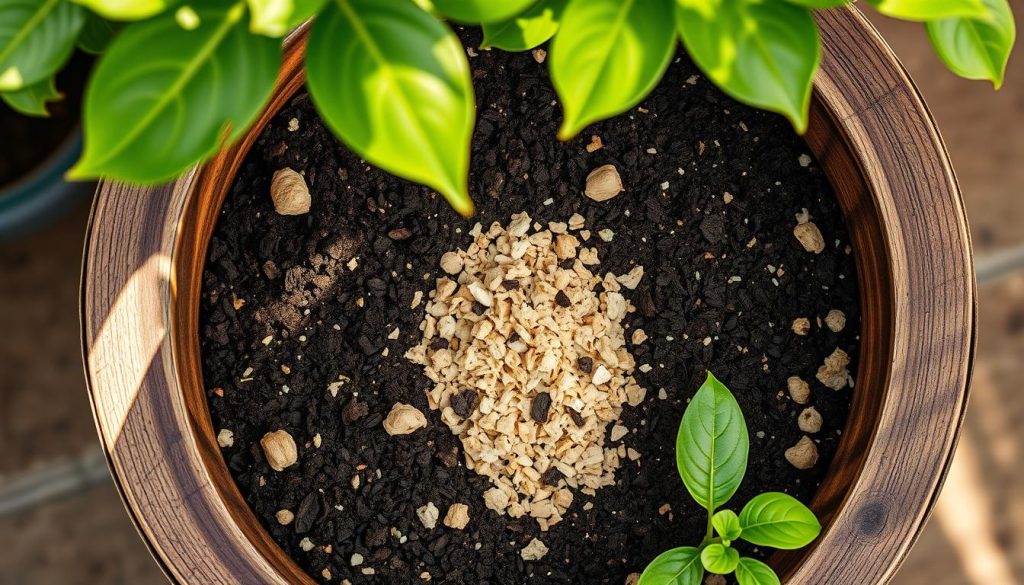
Key Components of Quality Container Soil
Creating a thriving container garden starts with the right soil. A top-notch soil mix for container plants is key. It should have organic matter, perlite, and vermiculite for healthy growth.
A balanced soil blend offers many benefits. It keeps moisture, provides nutrients, and ensures good drainage. This is vital for container plants, which can dry out and lack nutrients easily.
Organic Matter
Organic matter, like compost or peat moss, is crucial. It holds moisture, fights weeds, and feeds plants. Examples include:
- Compost
- Peat moss
- Manure
Perlite vs. Vermiculite
Perlite and vermiculite are common soil additives. Perlite helps with drainage and air, while vermiculite holds moisture and nutrients. The choice depends on the plants and climate.
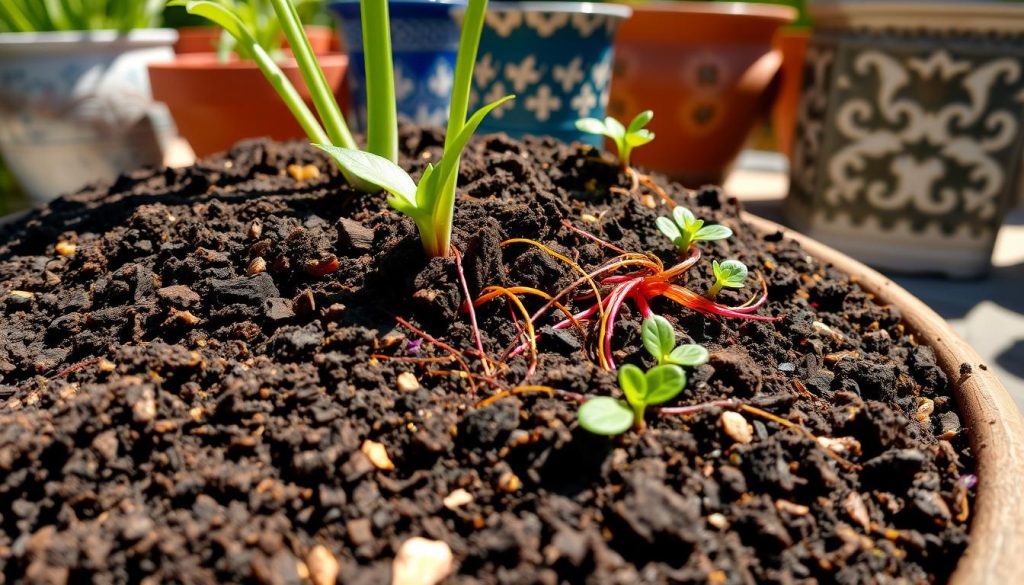
In summary, a balanced soil blend is vital for a thriving container garden. Mixing organic matter, perlite, and vermiculite gives plants the nutrients and support they need to thrive.
| Component | Benefits |
|---|---|
| Organic Matter | Retains moisture, suppresses weeds, provides nutrients |
| Perlite | Improves drainage and aeration |
| Vermiculite | Retains moisture, provides nutrients |
Types of Soil Mixes for Container Plants
Choosing the right soil for your container plants is key. You can pick premixed potting soil or make your own. Each has its own benefits and drawbacks. The best choice depends on your needs and what you like.
Premixed Potting Soil
Premixed potting soil is easy to find at gardening stores. It’s a mix of peat moss, vermiculite, and perlite, plus fertilizers. But, it might not fit your plants’ needs perfectly and can cost more than making your own.
Homemade Soil Mixes
Homemade mixes let you tailor the soil to your plants. You can mix compost, peat moss, and perlite. This way, you save money and control the soil quality.
Here’s a simple recipe for a homemade mix:
| Ingredient | Quantity |
|---|---|
| Compost | 2 parts |
| Peat moss | 1 part |
| Perlite | 1 part |
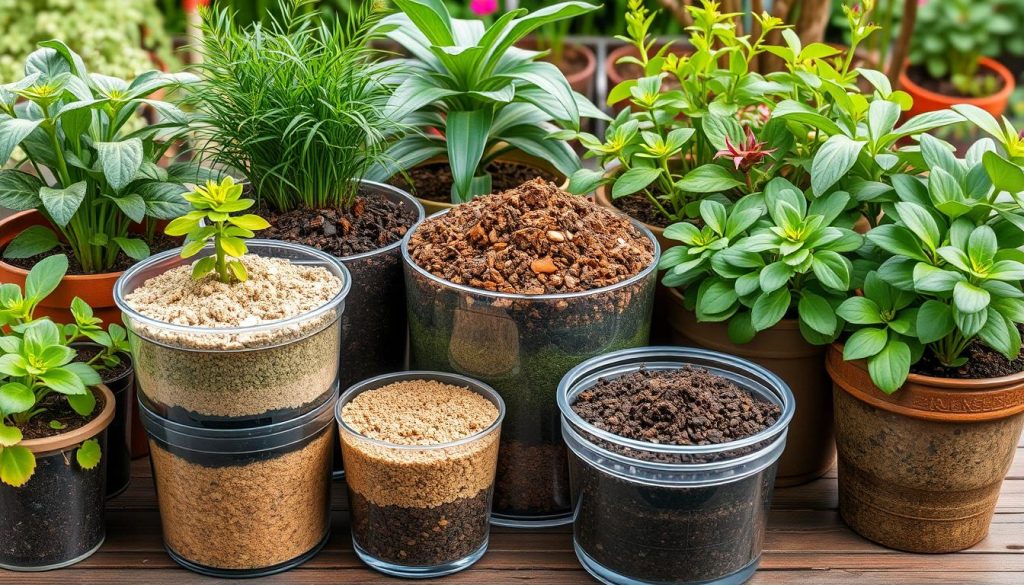
Choosing the right soil mix is crucial for your plants’ health. Whether you go for premixed or homemade, pick one that drains well and has the right nutrients.
How to Choose Soil Based on Plant Types
Choosing the right soil is key for container gardening. Different plants need different soils to thrive. I’ll guide you on picking the best soil for your plants, like vegetables, herbs, and flowers.
First, think about what your plants need. Vegetables and herbs like soil that drains well and is rich in organic matter. Flowers prefer slightly acidic soil that holds water well. Knowing these needs helps you pick the right soil for your plants.
Vegetables and Herbs
For veggies and herbs, look for soil with lots of organic matter. This keeps moisture in and provides nutrients. Good choices include:
- Soil mixes made for veggies and herbs
- Organic potting soils with compost or manure
- Homemade mixes of topsoil, compost, and perlite
Flowering Plants
Flowers need slightly acidic soil that holds water well. This supports healthy roots and prevents soggy soil. Good options for flowers are:
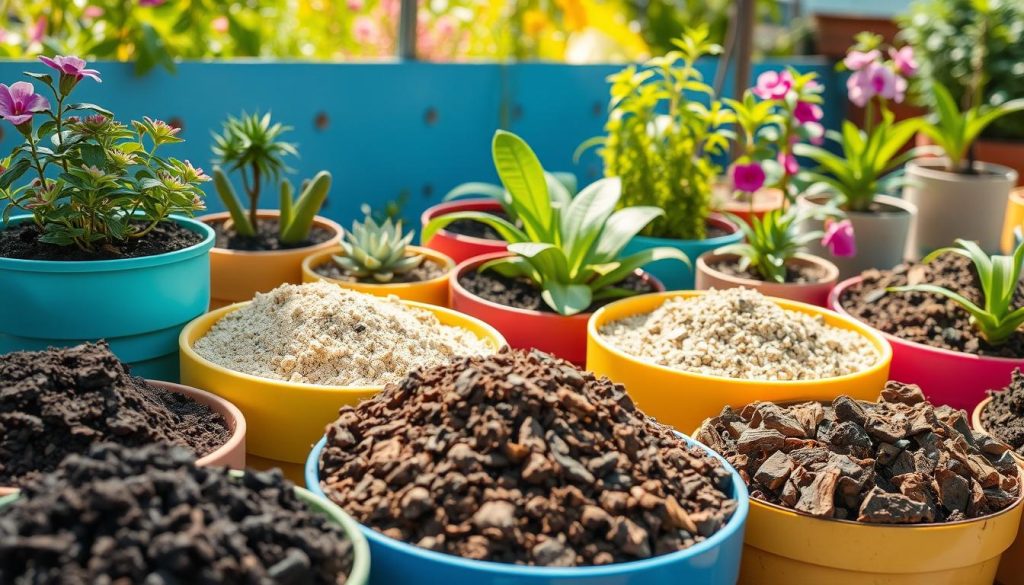
Choosing the right soil is crucial for your plants’ health. Pick a high-quality soil that fits your plants’ needs. Feel free to try different mixes to find the perfect one for your garden.
The Role of pH Levels in Soil Selection
Choosing the right soil mix for planters is key, and pH levels are a big part of it. Different plants need different pH levels. Using the best soil for plant containers can really help.
To find your soil’s pH level, you can use a testing kit or send a sample to a lab. After getting the results, you can add lime to raise it or sulfur to lower it. Remember, some plants are more sensitive to pH levels than others. So, it’s important to know what your plants need.
How to Test Soil pH
- Use a soil testing kit to determine the pH level of your soil
- Send a sample to a lab for analysis for more accurate results
- Research the specific pH requirements of your plants
Adjusting pH for Specific Plants
Changing your soil’s pH level is simple but must be done right. Too much lime or sulfur can harm your plants. So, always follow the recommended amounts.
By picking the best soil mix and adjusting the pH, you create a perfect growing space. Your plants will thrive, and you’ll enjoy a healthy garden all season.
Tips for Improving Soil Drainage
Improving soil drainage is key to stop waterlogged soil and root rot. In container gardening, a good soil mix is vital. A blend that drains well can greatly help your plants.
Adding Sand
To better soil drainage, add sand to your mix. Sand breaks up clay and improves soil structure. This lets water drain faster. You can also use perlite or vermiculite for better drainage.
Choosing the Right Container
Choosing the right container is also crucial. Look for ones with good drainage holes. This stops water from pooling in the soil. A container with a built-in water reservoir can also prevent overwatering.
Some tips for improving soil drainage include:
- Using a well-draining container gardening soil blend
- Adding sand or other materials to improve soil structure
- Choosing a container with good drainage holes
By following these tips, you can improve your container gardening soil’s drainage. Choose a high-quality soil and pick the right container for your plants.
Understanding Water Retention in Soil
As a gardener, I’ve learned that knowing how soil holds water is key. The right mix for pots balances water retention and drainage. This balance ensures plants get the right amount of moisture.
To get this balance, I use a few techniques. Moisture control with mulch is one of my favorites. Organic mulch, like bark chips or straw, keeps soil moist and cuts down on evaporation. This is great for plants like ferns and peace lilies that like steady moisture.
Monitoring Water Levels
It’s also important to watch how much water the soil has. I check the soil daily by sticking my finger in it. If it’s dry, it’s time to water. I also use a moisture meter for a precise reading.
Benefits of Mulch
Mulch does more than just control moisture. It also keeps weeds away, helps regulate soil temperature, and adds nutrients as it breaks down. Using mulch and the right soil mix makes my garden healthy and low-maintenance. Some benefits of mulch include:
- Improved soil structure
- Increased water retention
- Reduced weed growth
- Regulated soil temperature
Common Mistakes in Soil Selection
Choosing the right soil for container plants can be tricky. As a gardener, I’ve learned that the right soil is key to healthy plants. Here, I’ll share common mistakes to avoid when picking soil for your plants.
Drainage is a critical factor in soil selection. Without good drainage, plants can get waterlogged, leading to root rot. Choose a soil that drains well and meets your plants’ needs.
Overlooking Drainage Holes
Another mistake is forgetting to check for drainage holes in containers. Without these, water can build up, harming your plants. Always check your containers for holes before adding soil.
Ignoring Plant Size Needs
It’s important to think about your plants’ size when picking soil. Different plants need different soils. For example, vegetables and herbs need specific soils to grow well.
Avoiding these mistakes and choosing the right soil can ensure your plants’ health. Pick a high-quality soil that fits your plants’ needs. Don’t forget the importance of drainage holes and plant size.
- Drainage: Choose a soil that drains well to avoid waterlogged soil.
- Plant size: Select a soil that fits your plants’ size and growth needs.
- Soil type: Pick a soil made for your plants, like vegetables or herbs.
By following these tips and avoiding common mistakes, you can help your plants thrive. Enjoy a successful gardening experience with the best soil and the right container gardening soil.
Best Practices for Soil Maintenance
To keep your container plants healthy, maintaining the soil is key. An ideal soil mix for planters can greatly improve plant health. It should drain well, have a balanced pH, and the right nutrients.
Regular care is vital to prevent soil degradation. It ensures your plants get the nutrients they need. Here are some tips for soil health:
- Check the soil moisture regularly to avoid overwatering or underwatering
- Use a well-balanced fertilizer to provide essential nutrients
- Repot your plants every 1-2 years to refresh the soil
Refreshing Container Soil
Refreshing your container soil is easy. Just replace the old soil with a new, top-rated one. This replenishes nutrients and improves drainage.
Signs It’s Time to Change the Soil
Look out for signs like poor drainage, nutrient deficiencies, or pests. Recognizing these signs and acting on them can keep your plants healthy and productive.
By following these best practices and using the right soil, your plants will thrive. Always choose a top-rated soil for the best results.
Eco-Friendly Soil Options for Container Gardening
As a container gardener, I’m always searching for ways to lessen my environmental footprint. Using eco-friendly soil options is a big part of that. A balanced soil blend is key for plant health, and using recycled materials cuts down on waste. High-quality soil also ensures good drainage and water retention.
Using Recycled Materials
Recycled materials like compost and repurposed potting soil make for a unique soil blend. This method not only saves resources but also saves money. The benefits include:
- Reduced waste
- Cost-effective
- Improved soil structure
Benefits of Organic Soil
Organic soil is another green choice for container gardening. It lacks synthetic fertilizers and pesticides, making it better for plants and the planet. The advantages are:
- Improved soil fertility
- Increased crop yields
- Reduced environmental pollution
Choosing eco-friendly soil options, like high-quality container plant soil, helps us garden more sustainably.
Where to Buy the Best Soil for Container Plants
Now that you know what to look for in an optimal potting mix for pots, it’s time to find a reputable supplier. You have two main options: local garden centers and online retailers.
Local Garden Centers
Local garden centers are a great place to start. They carry a variety of soils and the staff knows a lot about them. You can ask for the best soil for your plants and get tips on how to use it.
Online Retailers
Online retailers are also a good choice. They have a wide selection of soils and customer reviews to help you decide. Check out Amazon, Home Depot, and Burpee. Make sure to read the product description and reviews to find the right potting mix.
Here are some tips for selecting a reputable supplier:
- Check the product description and reviews
- Look for certifications like USDA Organic or OMRI
- Read about the company’s values and mission
By following these tips and choosing a reputable supplier, you can find the best soil for your potted plants. This will help them thrive.
| Supplier | Product Options | Reviews |
|---|---|---|
| Local Garden Centers | Variety of soils from different brands | Knowledgeable staff |
| Online Retailers | Wide selection of soils | Customer reviews |
Conclusion: My Recommendations for Container Soil
As we wrap up our exploration of container gardening soil, I hope you feel ready to pick the best soil for your plants. The secret to a successful container garden is choosing the right soil mix for your plants.
Final Tips for Success
When picking best soil for container plants, focus on quality over price. Choose a container gardening soil that drains well, is rich in nutrients, and fits your plant’s needs. Keep the soil fresh and watch the moisture to keep your plants healthy and lively.
Get Started with Confidence
With what you’ve learned, you’re ready to choose the best soil for your container plants. Use your newfound knowledge to create a stunning and fruitful container garden. It will bring you joy for many years.

